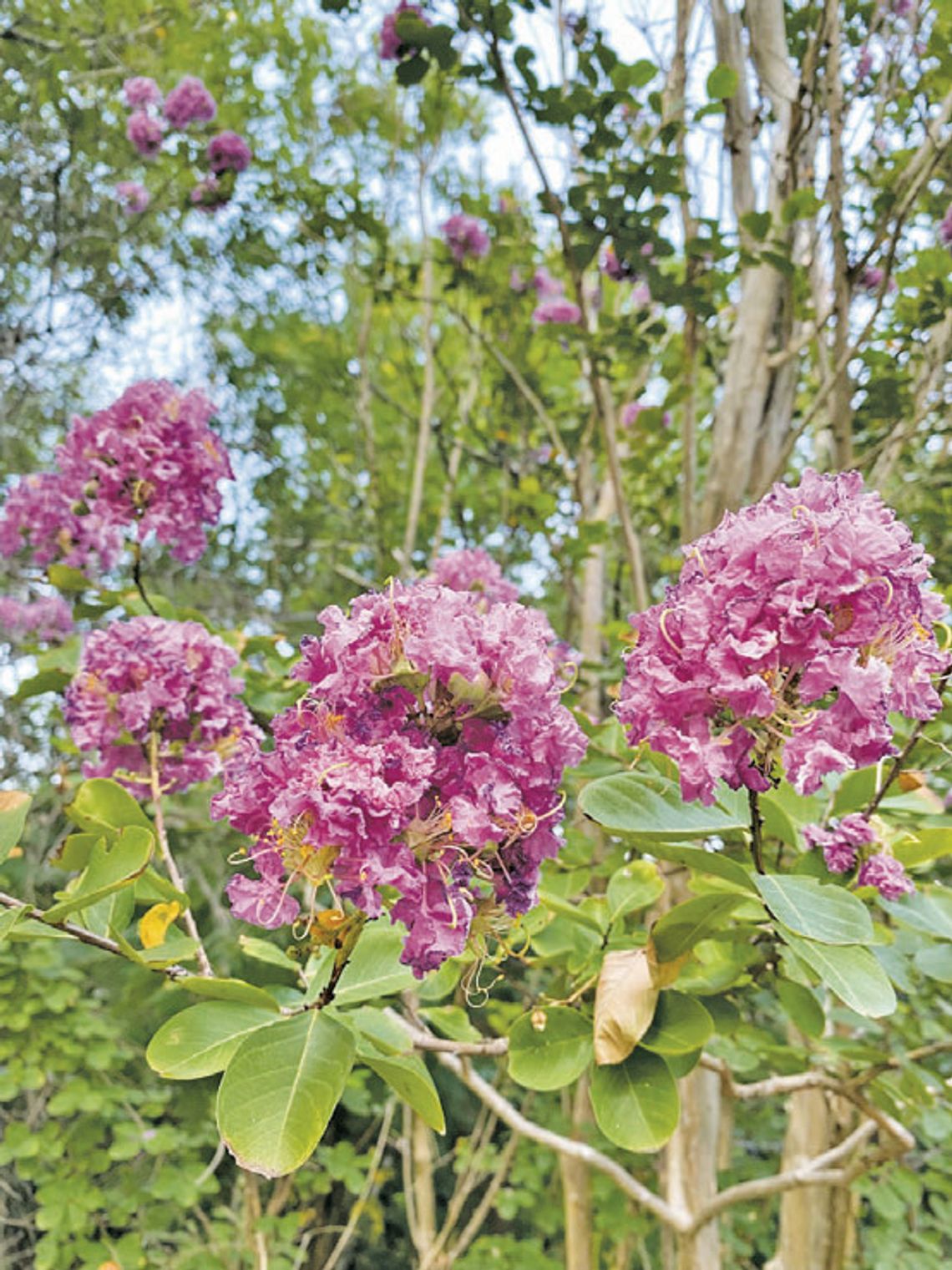PLOW AND HOSE ORGANIC GARDENING IN CENTRAL TEXAS | by Julie Rydell
Cooler temperatures and recent rains have stimulated many late summer blooming plants to flower profusely. Crape myrtles, in particular, have been quite showy in the last few weeks.
Depending on the variety, crape myrtles bloom from May through fall. Some of the early f lowering varieties can repeat bloom when conditions are favorable. Crape myrtles are wonderful plants for our Central Texas landscapes providing interest year-round.
In the spring, crape myrtles unfurl dark, glossy leaves. They bloom in a range of colors: whites, reds, lavender, purple plus all the shades of pink from pale to hot pink.
Central Texas isn’t known for having much of a colorful fall foliage, but crape myrtles have some of the best and most colorful foliage. Their leaves may be small, but they are one of the best plants if you love the fall color change. Crape myrtle leaves turn vibrant shades of highly saturated yellows, reds and orange.
Even in the winter, after they drop their leaves, crape myrtles continue to provide lots of interest to the landscape. Without leaves and flowers and nothing else to distract, crape myrtles draw your eye to their multi-trunk form.
Long, slender and smooth, crape myrtle trunks are reminiscent of cinnamon sticks. The bark sheds and peels off and leaves behind an interesting, mottled pattern on the trunks.
Initially, it may be unnerving since bark coming off trees is usually a bad sign. For crape myrtles, shedding bark is normal and actually an indication that they will be blooming soon. The thin bark will start to curl and then pull away from the trunk and fall to the ground. They shed last year’s bark in the summer right before they bloom. The old weathered, gray bark peels off and reveals the warm, rusty colored new growth underneath. It’s a lovely, dappled effect that is much more noticeable after the leaves drop.
Crepe myrtles are trees, but they come in as many different sizes as they do different colors. They range in size from dwarf trees that don’t get taller than 5 feet and are more like shrubs, to taller trees that can grow up to 50 feet.
There’s an intermediate size that gets to 12 feet tall.
Fall is a great time to plant trees and shrubs, so take advantage of this time of year to get some new plants in the ground. If you are wanting to add a crape myrtle to your yard, pay attention to the tag and variety so that you get the correct size for your space.
If you have established crape myrtles and they need to be shaped, wait until spring. Don’t prune or fertilize your crape myrtles in the fall. Allow them to go dormant in the winter so you have vigorous plants in the spring when they put on new growth. Fertilizing or pruning them now will stimulate them to grow when they need to be resting.
It is completely unnecessary to cut back your crape myrtles. You may see landscape companies or homeowners removing all top growth every fall, leaving sawed off trunks. This severe pruning is not needed–it does nothing to promote or stimulate more flowers in the spring. It is potentially very harmful.
Such severe pruning (or as some people call it Crape Murder) may not outright kill the tree but it does remove strong, viable limbs. It encourages weak, flimsy new growth that is unable to support the heavy blossoms that will come in the following spring. Severe pruning makes the crape myrtles susceptible to disease and rot, in addition to being ugly.
It’s not necessary and you don’t want to prune crape myrtles in the fall or the winter, anyway, let them rest and grow naturally.
With 25 years of backyard gardening experience, Julie is a plant and nature enthusiast. She lives in Taylor and hosts the “Plow & Hose Organic Gardening in Central Texas” podcast and radio show that airs on KBSR, Black Sparrow Radio every Saturday and Sunday at 9 a.m.





